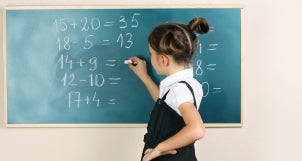Children entering grade 1 will be exposed to new subjects. This is not a simple problem for both children and parents. To prevent children from being discouraged or hating math, parents should equip their children with some grade 1 addition and subtraction math knowledge right at home.
Steps to help children solve addition and subtraction math in grade 1
Step 1: Use support tools
Supportive items such as counting sticks or Robot assembly toys with numbers from 5 to 9 and math markers will help children learn 1st grade addition and subtraction faster. To develop children's memory and imagination, parents should also use familiar objects around them, preferably things that children love to impress their children, such as stuffed animals and dolls. , toy cars …
In everyday life, parents should often give examples of math operations. For example: there are 3 motorbikes parked in front of the house, 1 motorbike runs away, then 2 more motorbikes arrive, then how many motorbikes are there in front of the house in total?

Supporting tools will lay the foundation for children to learn math better
Step 2: Teach your child how to count in pairs or by 5
Grade 1 addition and subtraction math will become simpler when your child knows how to double count 2, 4, 6, 8, etc. This will help your child understand that when he counts 2 consecutive units, it will create a sequence of numbers. there are rules. From there, your child will learn how to add and subtract even and odd numbers. Counting by 5 is also a similar method. Parents let their children count 5, 10, 15, 20... if it's too difficult to remember, you can apply this method. Count in a hide-and-seek game (five-ten game) to help your child memorize the number sequence faster.
Step 3: Help your baby get familiar with numbers
Before learning addition and subtraction math in grade 1 , parents should let their children become familiar with numbers. Once your child understands what numbers mean, learning math will become much simpler. Then, you can teach your child addition and subtraction with 1-digit numbers.
For example, parents can pose the problem "How many ways are there to create the equation equal to 6?" Then, the child will need to correctly answer calculations such as 6 + 0, 5 + 1, 4 + 2, 8 - 2,... is limited to numbers less than 10. Once your child gets used to this way of learning math, he or she will have better reflexes and thinking abilities.

Parents can buy their children a number board like this to help them get used to simple calculations
Step 4: Interesting tricks
In order for children to do well in 1st grade addition and subtraction math , parents should combine calculations with interesting numbers in mathematics, thereby making children less frustrated when exposed to mathematics. A typical example is the meaning of the number 0 in addition. Parents will use a quiz method and ask their children what answer 0 plus another number will give.
Even if you have only taught your child to calculate up to 20, you can still use big numbers like 100, 2000, 30,000 and ask your child for the answer. Your child will be surprised when the answer is the same number used to add. This method of teaching math has been used by many parents to get their children interested in the strangeness of mathematics.
Step 5: Change the learning format
Even when children learn simple math operations such as adding and subtracting 2 digits, or advanced math, the optimal method is still to combine homework with useful games so that children do not get bored.

If you just let your child do homework continuously, he or she will easily get bored
In addition, parents should also improve their ability to perform addition and subtraction calculations by: limiting homework time or asking their children to calculate when going to the market with their mother. Changing the learning atmosphere without having to limit learning to class and at home always helps children become more excited.
Some notes when teaching children math at home
Although the method of learning with sticks or counting with fingers is very effective in the early stages of learning math addition and subtraction in grade 1 . However, this way of learning only works for calculations with unit numbers. When children encounter larger numbers, they will not be able to do it. Not only that, if your child depends on this method of calculation, he or she will have limited thinking and reflexes.
Refer to the article: Super effective way to teach children to do mental arithmetic quickly according to their age
While studying, parents should also "clearly reward and punish". When your child can do the homework or remember to complete the assigned math problem, parents should give the child a small gift such as: candy, cake, toy... On the contrary, when the child refuses to do the homework, the parents will first give it to the child. You can remind, if this situation repeats, you need to apply strong measures such as: prohibiting your child from eating candy for 3 days, not buying the toy he likes because he has not fulfilled his promise to do his homework...

Correct reward and punishment will help your child take learning more seriously
Learning 1st grade addition and subtraction math is truly a difficult challenge for children, so parents need to be as patient as possible and talk often to understand their children's learning difficulties. The companionship of parents throughout the growing process will help children develop healthily and always feel happy.




